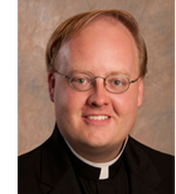|
In our last article we looked at how the sacramental character of Holy Orders conforms the priest to Christ, we are now going to examine three ways the priest resembles Christ, the Great High Priest. The first resemblance with Christ comes from the fact that the priest does not choose the priesthood for himself, it is not something that one can take on himself, it’s something which is given to him – he must be called to it. We hear Christ, in John’s Gospel say to His disciples: “you have not chosen me, but I have chosen you” (John 15.16). This is true for the priest himself, he has been chosen for it - it’s not something he takes for himself on his own initiative. In this we see a resemblance with Christ the Priest, because His own priesthood is a gift from His Father. For the priest this should be a constant reminder of the love that God has for him - that he has been chosen for so exalted a vocation.
The second resemblance we see between the priest and Christ the powers with which he is invested. The priesthood establishes an intermediary between God and the priest offers the gifts of human beings to God and the graces of God to human beings. The priest stands in the place of Christ and are clothed with His power. This power is something that comes from Christ Himself and entails the dispensing of the treasures and mercies of Christ Himself. We see this very clearly in the administration of the sacraments. If we look at the celebration of the Eucharist and the words of consecration, the priest says, “This is my Body, this is my Blood” – He speaks in the first person because he is acting in the person of Christ Himself. We see that too in the words of absolution on confession, “I absolve you” – once again speaking in the first person. This is a tremendous mystery and grace and in the words of Blessed Columba Marmion shows that that on earth there is nothing that can exceed the excellence of the priesthood. The final resemblance we will look at is rooted in the hypostatic union – that Christ is One Person with Two Natures – human and divine. In a certain way the priest bears in himself a divine element and a human element. Christ’s divinity was hidden under the veil of His humanity and, so too does the priest, under the exterior of a man, conceal within himself the invisible grandeurs of the priesthood. Such supernatural powers in such fragile hands! In one moment, at the word of the priest, bread becomes the Body and Blood of Christ. In one moment, at the word of the priest, a sinner is freed from his past sin, pardoned and made new again in grace. In our next article we will examine the call to sanctity which is an inherent part of the priesthood. (This article is part of a series of articles on The Sacraments which will appear in the bulletin over the course of this year.) Comments are closed.
|
Fr. PeterArchives
June 2023
Categories |
Join us at MassSaturday at 4pm;
Sunday at 7:30am, 9:00am, 10:30am Daily Masses: Monday-Friday 6:30am Tuesday/Friday 8::00am (school days only) Saturdays 8:00am Sacrament of Reconciliation |
|


 RSS Feed
RSS Feed
